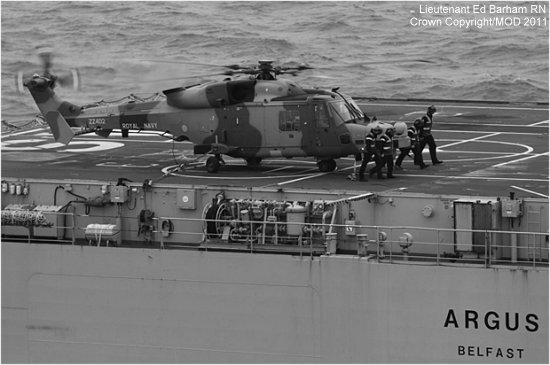
Royal Navy, November 09, 2011 - The Royal Navy's next-generation helicopter, the Wildcat, has landed on a ship at sea for the first time. On 7 November, the aircraft touched down on the flight deck of the Royal Fleet Auxiliary (RFA) aviation trials ship Argus off England's south coast, at the start of four weeks of tough trials for air and ground crew.
Wildcat is the 21st century variant of the Lynx helicopter which has served the Navy since the 1970s.
The landing on RFA Argus heralds four weeks of 'operating limit trials' for the Wildcat, which will lay the foundations for flying the new helicopter when it enters front line service.
A team from AgustaWestland, the Yeovil firm which builds the Lynx, experts from the Aircraft Test and Evaluation Centre at Boscombe Down, and Navy air engineers and technicians have joined Argus for the trials.
It fell to Lieutenant Commanders Robert Dowdell and Lee Evans to make the historic flight - assisted by a Lynx Mk8 of 815 Naval Air Squadron, which will get its hands on Wildcat in a little over two years' time:
"This marks a significant milestone in the life of Wildcat," said Lt Cdr Rob Taylor, Commanding Officer of 700W [W for Wildcat] Naval Air Squadron [NAS] - the trials unit set up at RNAS [Royal Naval Air Station] Yeovilton in Somerset specifically to bring the new aircraft into service.
"The deck landing's the first in a series of trials which will see Wildcat cleared to operate on all classes of Royal Navy and RFA ships in all theatres of the world."
Wildcat is bristling with new sensors and kit - improved radar, improved communications suite, more powerful engines, more firepower, and a 'glass' cockpit with four large display screens replacing the older dials and screens.
The cockpit's layout has been heavily influenced by input from the pilots and observers to allow them to find, collate and report contacts at sea or on land rapidly.
At the same time, engineers should find the Wildcat easier to maintain - which means the aircraft will have an even higher rate of availability than the already-reliable Lynx.
The first Wildcat arrives at Yeovilton, home of the Navy's entire Lynx Force, in January 2013, when the team at 700W NAS will determine how aircrews will operate the helicopter on deployment.
At the same time, a training course will be designed ahead of the first Wildcat crews converting from the existing Lynx joining 702 NAS, the Lynx operational training unit, in January 2014.
From there, the qualified fliers will move to the front line Lynx squadron, 815 NAS, which provides frigates, destroyers and the Navy's ice patrol ships with dedicated Flights of helicopters, plus air and ground crew, for their global deployments. The first Wildcat Flight is earmarked to deploy in 2015.
Some 66 Wildcats are being bought by the MOD, 38 for the Army Air Corps and 28 for the Fleet Air Arm. The Army variant is due to begin operations in 2014.
Wildcat is the 21st century variant of the Lynx helicopter which has served the Navy since the 1970s.
The landing on RFA Argus heralds four weeks of 'operating limit trials' for the Wildcat, which will lay the foundations for flying the new helicopter when it enters front line service.
A team from AgustaWestland, the Yeovil firm which builds the Lynx, experts from the Aircraft Test and Evaluation Centre at Boscombe Down, and Navy air engineers and technicians have joined Argus for the trials.
It fell to Lieutenant Commanders Robert Dowdell and Lee Evans to make the historic flight - assisted by a Lynx Mk8 of 815 Naval Air Squadron, which will get its hands on Wildcat in a little over two years' time:
"This marks a significant milestone in the life of Wildcat," said Lt Cdr Rob Taylor, Commanding Officer of 700W [W for Wildcat] Naval Air Squadron [NAS] - the trials unit set up at RNAS [Royal Naval Air Station] Yeovilton in Somerset specifically to bring the new aircraft into service.
"The deck landing's the first in a series of trials which will see Wildcat cleared to operate on all classes of Royal Navy and RFA ships in all theatres of the world."
Wildcat is bristling with new sensors and kit - improved radar, improved communications suite, more powerful engines, more firepower, and a 'glass' cockpit with four large display screens replacing the older dials and screens.
The cockpit's layout has been heavily influenced by input from the pilots and observers to allow them to find, collate and report contacts at sea or on land rapidly.
At the same time, engineers should find the Wildcat easier to maintain - which means the aircraft will have an even higher rate of availability than the already-reliable Lynx.
The first Wildcat arrives at Yeovilton, home of the Navy's entire Lynx Force, in January 2013, when the team at 700W NAS will determine how aircrews will operate the helicopter on deployment.
At the same time, a training course will be designed ahead of the first Wildcat crews converting from the existing Lynx joining 702 NAS, the Lynx operational training unit, in January 2014.
From there, the qualified fliers will move to the front line Lynx squadron, 815 NAS, which provides frigates, destroyers and the Navy's ice patrol ships with dedicated Flights of helicopters, plus air and ground crew, for their global deployments. The first Wildcat Flight is earmarked to deploy in 2015.
Some 66 Wildcats are being bought by the MOD, 38 for the Army Air Corps and 28 for the Fleet Air Arm. The Army variant is due to begin operations in 2014.
See also |
AW159 Wildcat HMA2 in




